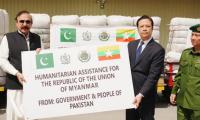One of India’s foremost and international prize winning journalists who is a trenchant critic of Modi’s policies has taken exception to the use of the word ‘genocide’ to describe the situation in Indian Occupied Kashmir.
According to him, the number of Kashmiri deaths since the August 5 lockdown is in the single digits. He cites the Oxford dictionary definition of genocide as the “mass extermination of human beings especially of a particular race or nation.” Accordingly, he says the claim that the current situation in Kashmir has even the makings of a future genocide is emotional exaggeration rather than fact. He feels the description “gross human rights violations” would be more accurate and less provocative. Somewhat polemically, he suggests Balochistan provides a better example of genocide.
Pakistan’s leaders have referred to the reality or prospect of genocide in Kashmir. They have even suggested Pakistan would approach the International Court of Justice in this regard. This writer has also used the word genocide when writing about the developing situation in IOK. There are, however, reports that some senior international diplomats have cautioned Pakistan against the use of extreme language.
Nevertheless, is the Oxford dictionary definition sufficient to make a determination of whether or not the use of ‘genocide’ properly applies to the current situation in Kashmir? Rather than dictionary definitions, we might inquire what international law has to say on the subject.
Article II of the Convention on the Prevention and Punishment of the Crime of Genocide (1948) defines genocide as “acts committed with intent to destroy, in whole or in part, a national, ethical, racial or religious group” which include (a) killing members of the group; (b) causing serious bodily or mental harm to members of the group; (c) deliberately inflicting on the group conditions of life calculated to bring about its physical destruction in whole or in part; (d) imposing measures intended to prevent births within the group; and (e) forcibly transferring children of the group to another group.
The above definition of genocide is regarded by many legal scholars as too narrow as it excludes many state actions that should be brought within the concept of genocide. Nevertheless, it demonstrates that genocide embraces a much wider range of acts against a targeted group than just their physical extermination. Moreover, it is a process that generally takes place and accumulates over time whether rapidly or less so. The question of ‘intent’ is, however, complicated. But systematic actions consistent with definitions of genocide, and ideological statements consistent with such actions by members of the ruling party provide strong indicators of intent.
Genocide Watch is an organization whose mission statement is “to predict, prevent, stop, and punish genocide and other forms of mass murder.” It has three levels of Genocide Alerts. One, Genocide Watch when there are signs of the early stages of the genocidal process. Two, Genocide Warning when the genocidal process has reached the stages of preparation by the perpetrators and persecution of the targeted group. And Three, Genocide Emergency when the genocidal process has reached the stage of genocidal massacres and other acts of genocide.
On August 16, 2019 eleven days after India’s revocation of the Special Autonomous Status of India Administered Jammu and Kashmi, Genocide Watch issued a Genocide Alert for the occupied state. The alert noted that “In 1984 Kashmiri Muslim youth began demonstrations for Kashmiri indigenous self-determination that were crushed by Indian armed forces.” It also noted that Muslim riots destroyed Hindu properties and insurgent attacks on the Hindu community led to the fleeing of 100,000 Kashmiri Pandits from the Valley.
It referred to the Human Rights Watch report that 50,000 people were killed in Kashmir from 1989 to 2006. It also referred to 40 mass graves (all Muslim), 8000 disappearances (all Muslim,) and that by 2016 there were over 70,000 killings, mostly by Indian forces. It quoted Amnesty International reports that “disappearances, torture and rape by Indian Army units against Kashmiri Muslims are common.”
Genocide Watch’s Genocide Alert on Kashmir also referred to post August 5 “early warnings” of massacres in Kashmir including: (i) prior genocidal massacres and continuing impunity for such killings; (ii) continued armed conflict between India and Pakistan over border areas in Kashmir; (iii) an exclusionary ideology of “Hindutva” by Modi’s ruling BJP; (iv) authoritarian military rule without legal restraints imposed by civilian Indian officials; (v) rule by a minority military force (Hindus and Sikhs) over majority Muslim civilians; (vi) cut-off communications and outside access by internet, media and trade; and (vii) widespread violations of basic human rights – torture, rape, two-year detentions without charge, arbitrary arrests and deportations of Muslim political and human rights leaders.
Apart from the early warnings, Genocide Watch noted that its Ten Stages of the genocidal process were “far advanced” in the case of Kashmir. These included: (i) Classification: Hindu and Sikh Army “us” versus Kashmiri Muslim civilian “them”; (ii) Symbolization: Muslims have Muslim names (on ID cards), Kashmiri language, dress, mosques; (iii) Discrimination: Hindu Pandits were economically dominant until 1990; the BJP reasserted Hindu power; (iv) Dehumanization: Muslims are called “terrorists”, “separatists”, “criminals”, “insurgents”.
And: (v) Organization: 600,000 heavily armed Indian Army troops and police dominate Kashmir; (vi) Polarization: Modi and the BJP incite anti-Muslim hatred; social media spread falsehoods; (vii) Preparation: The Indian Army occupies Kashmir; BJP leaders speak of the “Final Solution” for Kashmir; (viii) Persecution: Kasmiri Muslims are locked down, subject to arrest, torture, rape and murder; (ix) Extermination: Genocidal massacres occurred during Partition; since 1990 there have been at least 25 massacres with death tolls over 25, 10 of Muslims by Hindu troops, and 15 of Hindus by Muslim militants; and (x) Denial: Modi and the BJP say their goals are to “bring prosperity” and “end terrorism”; they deny any massacres. No Indian Army troops or police are ever tried for torture, rape or murder. Modi’s takeover is popular in India.
This description of the stages of the genocidal process seems consistent with the Oxford dictionary definition of genocide or at least of one in the making. The president of Azad Jammu and Kashmir says if the massacre of around 300,000 Muslim Kashmiris in Jammu by RSS forces and many more forced to flee to Azad Kashmir and Pakistan in 1947, along with the more than 100,000 killed in the Valley since 1989, are taken into account then genocide has already taken place and is continuing to take place. In addition, there are the blistering UN Human Rights Commission reports on the state of human rights in IOK. To be exact, they have also been critical – if to a much lesser extent – of the state of human rights in AJK.
There is another misconception which is prevalent in Pakistan. The argument that Pakistan’s nuclear deterrent should not exclude the people of the Kashmir Valley if the current Indian repression reaches the level of a Genocide Emergency is not an argument for war as many self-styled liberals seem to insist; it is in fact designed to deter a mutually suicidal war.
Of course, war can also be avoided by a meek surrender to full-blown genocide in IOK. In that case, the question would arise: how long would such a Pakistan survive? Many, however, still insist Kashmir is gone; the imperative must now be to save Pakistan. In that case, Indian salami tactics could threaten AJK? What would our peaceniks say in that event? I ask this question as one who has contempt for hawkish policies instead of people policies.
There is the further matter of the Indian journalist’s reference to Balochistan. While the reference is more polemical than indicative of any real concern, for Pakistanis the twin realities of seriously poor national and provincial governance at home and the consequent projection of a seriously poor national image abroad should be matters of the most urgent concern. No matter what the real situation in IOK may be, as long as Pakistan is unable to come to grips with its several existential deficiencies at home it can be of little use to itself or its Kashmiri brothers and sisters.
None of this is news to informed Pakistanis. But all of this has yet to move them to be the active citizens Pakistan desperately needs. In these circumstances, responding to the criticisms of Indian commentators can only be meaningful if Pakistan can rise above its past and present to secure its own future.
The writer is a former ambassador to the US, India and China and head of UN missions in Iraq and Sudan.
Email: ashrafjqazi@gmail.com
This demand has fueled rapid growth deposit base of Islamic Banks and Islamic Windows operated by conventional banks
But Punjab Agriculture Food and Drug Authority building near Thokar Niazbeg on Multan Road stands out
Macron has been particularly vocal in their criticism, asserting that withholding arms from Kyiv plays directly into...
As PPP governs province, Bilawal Bhutto Zardari holds strategic position to address both violence and its underlying...
Critics argue that strategy is vague, but closer look indicates strategic alignment with global trends and national...
To defeat it, we must distrust bot-driven narratives, to defeat it, we must verify sources before believing or sharing







